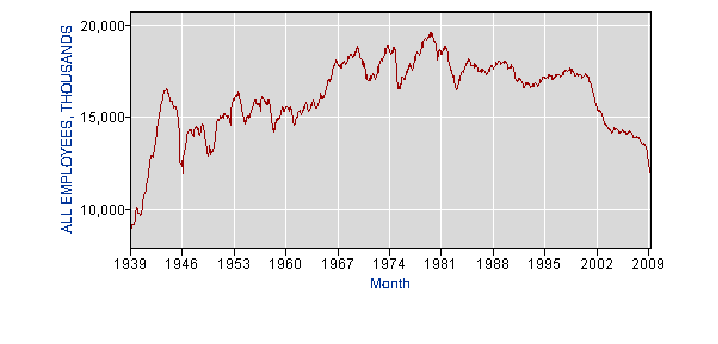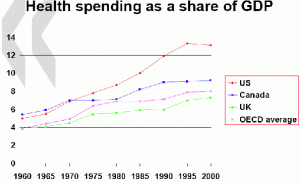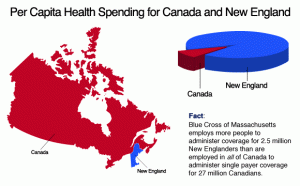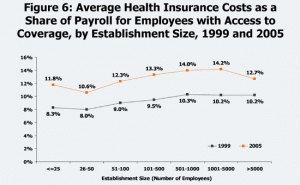
Manufacturing employment from 39
Fun graph, eh?
This is your manufacturing economy on globalization. Bear in mind that these numbers are absolute numbers, they don’t reflect the fact that the US population has grown significantly.
a high level Obama administration economic adviser is quoted as saying that America’s export future resides in exporting “consulting and legal services, software, movies, and medicine.”
Whistling past the graveyard would be the kind way to characterize that statement. Typical Summers/Geithner “brilliance” might be the less kind way of putting it.
US manufacturing was never going to stay as high as it was, relative to the size of the population, after World War II. The majority of the world’s manufacturing capacity had just been bombed into rubble, after all. A relative decline was always to be expected.
An absolute decline, however, is quite another matter, so let’s do a 30 second seminar on international trade and development.
No country other than a city state has ever industrialized except behind trade barriers. None. There are no exceptions. Mercantalism is how states industrialize. The trade barriers can be classic tariffs (like the US used), they can be direct subsidies, they can be through interest rate policy or they can be through making your currency cheaper than it otherwise would be.
For good chunks of the 2000’s, the Chinese government spent about 10% of their entire GDP keeping the Yuan undervalued. Other countries, like Japan and Korea also worked hard to keep their currencies undervalued (or the US dollar propped up, depending on how you want to look at it.) This made their goods more competitive than they would have been otherwise and the direct result was the loss of US manufacturing jobs. (One might also point out that this doesn’t qualify under any definition as “free” trade).
This isn’t the entire picture, just dropping the dollar won’t fix the problem, because if that happens, the US gets creamed on resource costs (read: OIL). This means the US is in a policy bind. Drop the dollar and get slaughtered by resource prices. Keep the dollar high, and lose jobs.
This isn’t just a policy bind, it’s co-dependency, in the worst sense, like when a drug dealer needs a customer’s cash and the customer needs his fix. Americans got something in exchange for this: they got cheap consumer goods, and funding for their overspending. At some points during the 00’s the American savings rate was negative!
In exchange manufacturing and other jobs were moved directly overseas. Off-shoring went to China, outsourcing (of legal, administrative, call center and whatnot) went to India, Canada and Ireland (because they all have large numbers of English speakers).
Breaking this policy bind is simple enough: first you have to break US dependence on oil, then you can tell the countries which are selling you drugs (which you desperately want and need, don’t blame them for your addiction to cheap credit and consumer goods) where to go. Then you go through a very unpleasant withdrawal period, which as any ex-addict can tell you, is hell on earth.
But the status quo isn’t so hot either, is it?
Want your manufacturing jobs back? Get off oil, then you can get off easy foreign credit and cheap consumer goods. Then you can have them back. And maybe once they’re back we’ll be able to buy an appliance which isn’t so lousy that it’s expected to wear out in 5 years max and be thrown to the curb.
One can dream.



